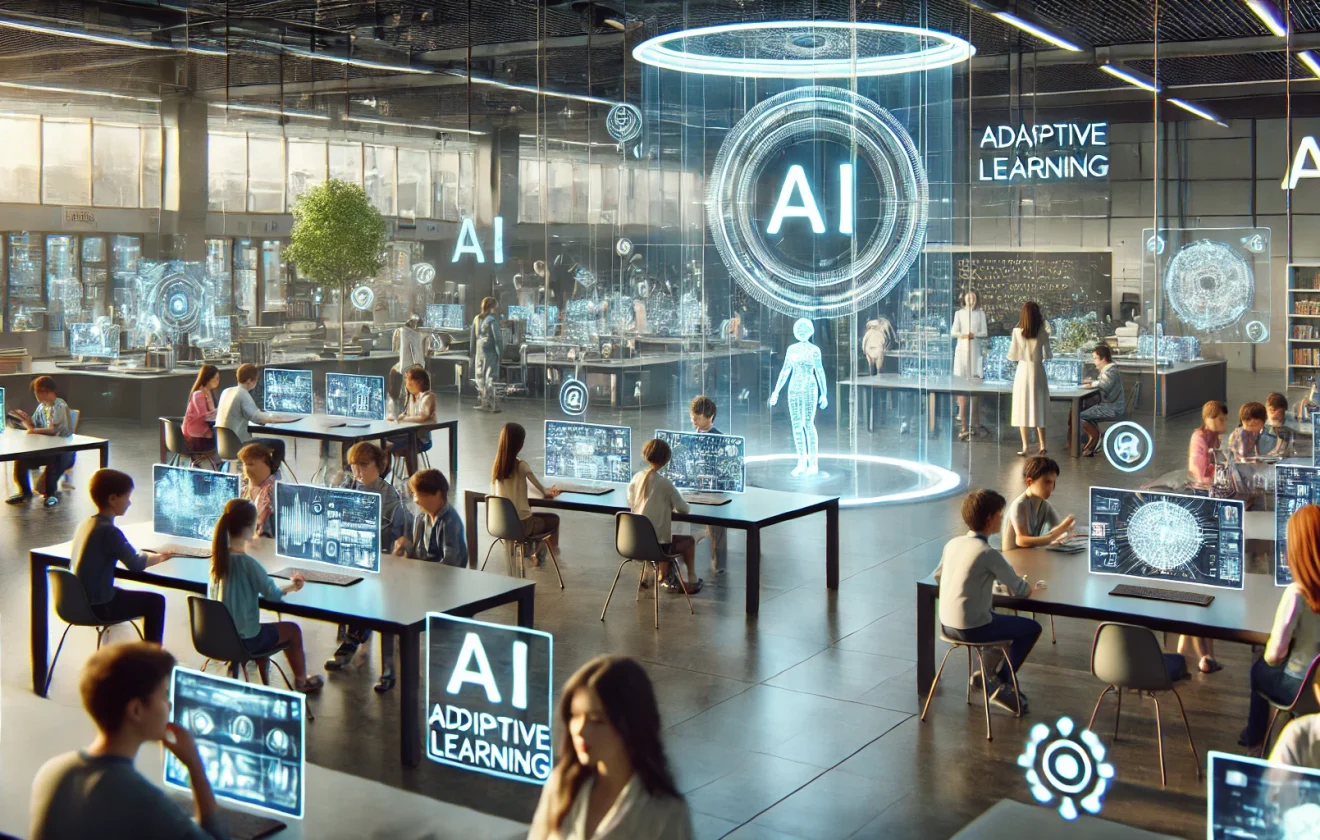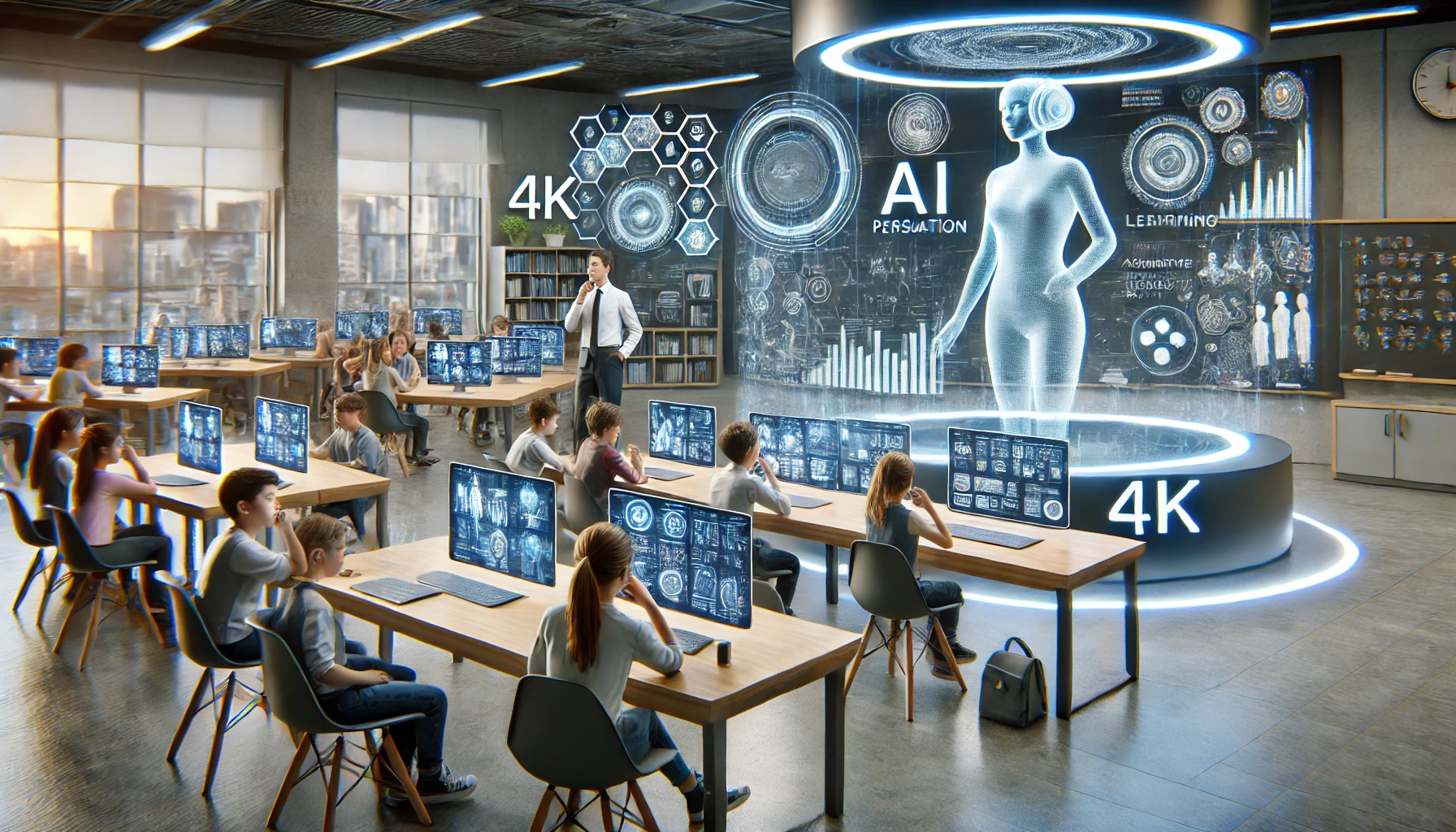AI and Education: Revolutionizing Personalized Learning Experiences
Education is the cornerstone of societal progress, and as technology evolves, its impact on learning becomes increasingly profound. Artificial Intelligence (AI) stands at the forefront...

- The Role of AI in Personalized Learning
- Key Benefits of AI-Driven Learning Systems
- <strong>1. Individualized Learning Paths</strong>
- <strong>2. Real-Time Feedback and Support</strong>
- <strong>3. Enhanced Engagement Through Interactive Tools</strong>
- <strong>4. Scalability and Accessibility</strong>
- <strong>5. Reduced Workload for Educators</strong>
- <strong>6. Inclusive Learning Opportunities</strong>
- <strong>7. Lifelong Learning and Career Preparation</strong>
- <strong>8. Data-Driven Insights for Continuous Improvement</strong>
- Challenges in Implementing AI in Education
- <strong>1. High Initial Costs</strong>
- <strong>2. Digital Divide and Accessibility Issues</strong>
- <strong>3. Data Privacy and Security Concerns</strong>
- <strong>4. Ethical Considerations in AI Deployment</strong>
- <strong>5. Resistance to Change Among Educators</strong>
- <strong>6. Lack of Standardization</strong>
- <strong>7. Over-Reliance on Technology</strong>
- <strong>8. Continuous Upgrades and Maintenance</strong>
- <strong>9. Limited Customization for Diverse Educational Contexts</strong>
- <strong>10. Balancing Automation and Human Touch</strong>
- Real-World Examples of AI-Powered Personalized Learning
- <strong>1. Duolingo: Revolutionizing Language Learning</strong>
- <strong>2. Carnegie Learning: AI for Mathematics Mastery</strong>
- <strong>3. Google Read Along: Supporting Early Literacy</strong>
- <strong>4. Squirrel AI Learning: Pioneering Adaptive Education in China</strong>
- <strong>5. Century Tech: Enhancing Teacher Support in the UK</strong>
- <strong>6. Khan Academy: AI-Driven Skill Development</strong>
- <strong>7. Content Technologies Inc. (CTI): Automating Curriculum Creation</strong>
- <strong>8. Quizlet: AI for Efficient Studying</strong>
- <strong>9. IBM Watson Education: AI for Classroom Analytics</strong>
- <strong>10. AltSchool: Redefining K-12 Education in the US</strong>
- <strong>Impact of These Examples</strong>
- The Future of AI in Education: Trends and Possibilities
- <strong>1. Hyper-Personalized Learning at Scale</strong>
- <strong>2. Integration of Virtual and Augmented Reality (VR/AR)</strong>
- <strong>3. Expansion of AI-Powered Lifelong Learning Platforms</strong>
- <strong>4. Emotional AI for Holistic Education</strong>
- <strong>5. Collaborative Learning with AI Assistants</strong>
- <strong>6. Democratization of Quality Education</strong>
- <strong>7. Enhanced Teacher Support and Professional Development</strong>
- <strong>8. Ethical AI Frameworks in Education</strong>
- <strong>9. AI-Powered Assessment and Credentialing</strong>
- <strong>10. Autonomous Learning Systems</strong>
- 1
Final Thoughts on the Future

The future of AI in education is one of boundless potential, with the promise of creating learning environments that are more inclusive, engaging, and effective. By addressing current challenges and embracing emerging trends, AI can empower students and educators to achieve unprecedented levels of success. As we navigate this exciting frontier, collaboration between technologists, educators, and policymakers will be essential to ensure that AI’s impact on education is both meaningful and equitable.
- FAQ: AI and Education: Revolutionizing Personalized Learning Experiences
- What is personalized learning in education?
Personalized learning tailors the educational experience to the unique needs, preferences, and pace of each student. It adapts content, teaching methods, and assessments to help learners achieve better outcomes and stay engaged.
- How does AI enable personalized learning?
AI enables personalized learning by analyzing student data to identify strengths, weaknesses, and learning patterns. It uses this information to adjust content delivery, recommend resources, and provide real-time feedback, creating a customized learning experience for each student.
Education is the cornerstone of societal progress, and as technology evolves, its impact on learning becomes increasingly profound. Artificial Intelligence (AI) stands at the forefront of this transformation, introducing personalized learning experiences that adapt to the unique needs of each student. Unlike traditional methods that adopt a one-size-fits-all approach, AI-powered systems tailor content, pace, and methods of teaching to optimize outcomes for learners.
Imagine a classroom where every student progresses at their ideal speed, receives immediate feedback, and gains access to resources aligned with their individual strengths and challenges. With AI, this vision is becoming a reality. By analyzing vast amounts of data, AI identifies learning patterns, predicts challenges, and provides solutions in real-time, creating an engaging and efficient educational journey.
However, integrating AI into education isn’t without its challenges. Issues such as accessibility, teacher training, and ethical considerations require careful navigation. Yet, the promise of AI-driven personalized learning is undeniable: improved academic performance, higher engagement levels, and the democratization of quality education worldwide.
In this article, we delve into how AI reshapes education by offering personalized learning experiences. We explore its benefits, challenges, real-world applications, and future trends to provide a comprehensive understanding of this revolutionary intersection of AI and learning.
The Role of AI in Personalized Learning#
Artificial Intelligence is redefining the traditional landscape of education by enabling personalized learning experiences that cater to individual needs. At its core, personalized learning involves adapting the pace, content, and style of teaching to suit the unique preferences and abilities of each student. AI technologies, through their data-driven approach, play a pivotal role in achieving this personalization.
Adaptive Learning Systems#
AI-powered adaptive learning systems, such as intelligent tutoring programs, continuously analyze a student’s progress. They identify strengths, weaknesses, and patterns of understanding. For example, if a student struggles with algebra, the system might prioritize foundational concepts before advancing to more complex topics. This tailored approach not only enhances comprehension but also boosts confidence, as students can progress at a pace that feels right for them.
Dynamic Content Delivery#
AI facilitates dynamic content delivery by recommending resources suited to the learner’s style. Visual learners might be guided to video tutorials, while those who thrive on interaction could be directed to gamified learning modules. Additionally, AI can generate quizzes, practice problems, or even simulate real-world scenarios based on the learner’s progress, ensuring that engagement remains high.
Natural Language Processing (NLP) in Education#
NLP-based tools, such as AI-driven writing assistants and language learning applications, provide real-time feedback. These tools help students refine their grammar, structure essays, and even practice new languages by engaging in simulated conversations. NLP further aids educators in grading assignments more efficiently and offering detailed insights into areas where students may need additional support.
AI in Classroom Management#
AI doesn’t just benefit students; it also equips teachers with powerful tools. Automated attendance systems, performance tracking dashboards, and predictive analytics enable educators to focus more on teaching and less on administrative tasks. These systems identify at-risk students early, allowing timely interventions to keep them on track.
Emotional and Behavioral Insights#
AI can analyze not only academic progress but also emotional and behavioral cues through advanced algorithms. For instance, facial recognition and sentiment analysis tools can help identify if a student is disengaged, stressed, or struggling emotionally. Such insights enable teachers and counselors to provide targeted support, fostering a healthier learning environment.
Global Accessibility#
Personalized learning through AI extends beyond geographical and socioeconomic barriers. Platforms powered by AI can be accessed anywhere, providing students in remote or underserved areas with resources and guidance that would otherwise be unavailable. This democratization of education brings quality learning to the fingertips of millions.
While AI’s role in personalized learning is transformative, it is important to remember that these systems are designed to complement, not replace, human educators. Teachers remain integral to fostering creativity, critical thinking, and emotional intelligence—areas where human connection is irreplaceable.
Key Benefits of AI-Driven Learning Systems#
The integration of Artificial Intelligence (AI) into education offers numerous benefits that enhance the learning experience for students and simplify instructional processes for educators. These advantages underscore why AI-driven learning systems are becoming a critical component of modern education.
1. Individualized Learning Paths#
AI tailors learning experiences to fit each student’s unique abilities, interests, and pace. Unlike traditional classrooms, where all students follow the same curriculum, AI adapts the content based on individual progress. For instance, students struggling with a concept can receive extra resources or alternative explanations, while advanced learners can explore more challenging topics. This personalization fosters a deeper understanding and helps each student reach their full potential.
2. Real-Time Feedback and Support#
AI systems provide immediate feedback on assignments, quizzes, and activities. For example, if a student makes an error in a math problem, the AI can identify the specific mistake and offer an explanation to correct it. This immediate support prevents students from reinforcing incorrect concepts and ensures they stay on track. Moreover, AI tutors are available around the clock, enabling students to learn at their convenience without waiting for a teacher’s response.
3. Enhanced Engagement Through Interactive Tools#
AI-driven tools, such as gamified learning platforms and virtual simulations, make education more engaging. These tools encourage active participation by turning lessons into interactive experiences. For example, AI-based platforms like Duolingo or Prodigy use games to teach languages or mathematics, motivating students to learn while enjoying the process. Engaged learners are more likely to retain information and develop a positive attitude toward education.
4. Scalability and Accessibility#
One of the most transformative aspects of AI is its ability to make quality education scalable and accessible. AI platforms can accommodate millions of users simultaneously, ensuring that students worldwide have access to the same high-quality learning materials. For learners in remote or underserved regions, AI-powered systems bridge gaps in resources, bringing world-class education to their fingertips.
5. Reduced Workload for Educators#
AI automates time-consuming administrative tasks, such as grading, tracking attendance, and analyzing student performance. This allows teachers to focus on providing personalized support and fostering meaningful interactions with their students. Tools like predictive analytics help educators identify struggling students early, enabling timely interventions.
6. Inclusive Learning Opportunities#
AI-driven systems excel at accommodating diverse learning needs. For students with disabilities, AI tools offer adaptive features like voice recognition, text-to-speech, and screen readers. For instance, visually impaired students can use AI systems to access digital learning materials in audio format, while students with hearing impairments can rely on automatic captioning and sign-language translation.
7. Lifelong Learning and Career Preparation#
AI doesn’t just benefit school-age students; it supports lifelong learning. For professionals seeking to upskill or reskill, AI platforms offer customized courses that align with their career goals. Additionally, AI-powered career advisors analyze individual interests and skills, suggesting tailored career paths and training programs.
8. Data-Driven Insights for Continuous Improvement#
AI systems collect and analyze vast amounts of data, providing insights into what works and what doesn’t. Educators can use this information to refine teaching strategies, adjust curricula, and improve learning outcomes. For example, if data reveals that a majority of students struggle with a particular concept, teachers can revisit their approach to that topic.
AI-driven learning systems are transforming education by making it more inclusive, efficient, and effective. By addressing individual needs and providing dynamic support, these systems are paving the way for a future where every student can thrive in their educational journey.
Challenges in Implementing AI in Education#
While the potential of Artificial Intelligence (AI) in education is immense, its implementation comes with significant challenges. These barriers must be addressed to fully harness AI’s capabilities and ensure equitable, ethical, and effective deployment in educational settings.
1. High Initial Costs#
AI systems require substantial investment in hardware, software, and infrastructure. Many educational institutions, particularly those in underfunded areas, may struggle to afford the necessary technology. From procuring high-quality devices to maintaining servers and cloud storage, the financial burden can deter schools from adopting AI-powered solutions.
2. Digital Divide and Accessibility Issues#
The digital divide remains a significant obstacle. Students in low-income or rural areas often lack access to the internet or the devices needed for AI-based learning. This inequality risks leaving disadvantaged students even further behind, widening the educational gap that AI aims to bridge.
3. Data Privacy and Security Concerns#
AI systems collect vast amounts of data to provide personalized learning experiences, raising concerns about privacy and data security. Sensitive student information, such as academic performance and behavioral patterns, could be at risk of misuse if robust security measures aren’t in place. Ensuring compliance with regulations like GDPR or COPPA and maintaining transparent data policies are critical to addressing these concerns.
4. Ethical Considerations in AI Deployment#
The use of AI in education introduces ethical dilemmas, including potential biases in algorithms. For instance, an AI system might unintentionally favor certain groups over others based on the data it was trained on. Ensuring that AI models are unbiased, inclusive, and transparent is crucial to prevent discrimination and foster fairness in education.
5. Resistance to Change Among Educators#
Many educators may feel apprehensive about integrating AI into their classrooms, fearing it could replace their roles or add complexity to their teaching routines. There is also a learning curve associated with using AI tools effectively. Comprehensive teacher training programs are essential to address this resistance and empower educators to view AI as a supportive ally rather than a threat.
6. Lack of Standardization#
AI in education is still an emerging field, and there is little consensus on best practices or standard protocols. This lack of standardization can lead to inconsistencies in how AI tools are implemented and evaluated across schools and regions. Developing universally accepted guidelines is necessary for ensuring uniformity and effectiveness.
7. Over-Reliance on Technology#
While AI offers remarkable advantages, an over-reliance on technology could lead to unintended consequences. For example, students might develop a dependency on AI tools, which could hinder the development of critical thinking and problem-solving skills. Striking a balance between technology and traditional learning methods is crucial.
8. Continuous Upgrades and Maintenance#
AI systems require regular updates to stay effective and secure. Educational institutions may find it challenging to keep up with the fast-paced advancements in AI technology. Without consistent maintenance and upgrades, these systems risk becoming obsolete or vulnerable to cyber threats.
9. Limited Customization for Diverse Educational Contexts#
AI solutions often operate on pre-designed algorithms that may not be adaptable to every educational context. For instance, cultural differences, curriculum variations, and language barriers can limit the effectiveness of a one-size-fits-all AI solution. Developers must work closely with educators to design systems that are culturally sensitive and contextually relevant.
10. Balancing Automation and Human Touch#
AI’s automation capabilities, while beneficial, must not replace the human elements of education. Emotional intelligence, creativity, and mentorship are aspects of learning that only human educators can provide. A successful AI implementation should aim to complement, not substitute, the human touch in education.
Addressing these challenges requires collaboration between educators, policymakers, technology developers, and communities. By overcoming these hurdles, AI can achieve its full potential as a transformative force in education, ensuring equitable access to personalized learning for all.
Real-World Examples of AI-Powered Personalized Learning#
The transformative impact of Artificial Intelligence (AI) on education can already be seen in real-world applications across the globe. These examples demonstrate how AI-powered systems are providing students with personalized learning experiences, supporting teachers, and improving educational outcomes.
1. Duolingo: Revolutionizing Language Learning#
Duolingo, one of the most popular language learning apps, leverages AI to create personalized learning pathways. The app analyzes user behavior, identifies areas where learners struggle, and adjusts lessons accordingly. Through gamification and interactive exercises, Duolingo keeps learners engaged while ensuring they build proficiency at their own pace. Its use of AI-driven adaptive learning models has set a benchmark for other educational apps.
2. Carnegie Learning: AI for Mathematics Mastery#
Carnegie Learning offers AI-driven math tutoring solutions that adapt to individual student needs. The platform uses machine learning algorithms to analyze student performance and identify gaps in understanding. By providing targeted exercises and real-time feedback, Carnegie Learning helps students strengthen their foundational skills, boosting their confidence and academic performance.
3. Google Read Along: Supporting Early Literacy#
Google’s Read Along app is an AI-based tool designed to help children improve their reading skills. The app uses speech recognition technology to listen to children read aloud and provides instant feedback on pronunciation and fluency. This interactive approach motivates young learners to practice regularly and develop strong literacy skills early in life.
4. Squirrel AI Learning: Pioneering Adaptive Education in China#
Squirrel AI, a leading education technology company in China, has developed an AI-powered platform that personalizes learning for K-12 students. The system evaluates a student’s knowledge level, learning speed, and preferred study methods, offering customized lesson plans and exercises. By tailoring the curriculum to each student’s unique profile, Squirrel AI has achieved significant improvements in learning outcomes.
5. Century Tech: Enhancing Teacher Support in the UK#
Century Tech combines AI with neuroscience to support both students and educators. Its platform provides personalized learning recommendations to students while offering actionable insights to teachers. For example, the system identifies which topics students find challenging and suggests specific interventions to address those difficulties. This dual benefit has made Century Tech a valuable tool in classrooms across the UK.
6. Khan Academy: AI-Driven Skill Development#
Khan Academy, a global leader in free online education, uses AI to deliver personalized learning experiences. Its platform tracks student progress, identifies weak areas, and offers tailored lessons to address those gaps. Khan Academy’s partnership with OpenAI also explores the use of generative AI to provide conversational tutoring, further enhancing its personalized approach.
7. Content Technologies Inc. (CTI): Automating Curriculum Creation#
CTI utilizes AI to create custom educational content, such as textbooks and lesson plans. By analyzing curriculum requirements and student needs, CTI’s platform generates tailored materials that align with educational standards. This automation reduces the workload for educators while ensuring high-quality resources are available to students.
8. Quizlet: AI for Efficient Studying#
Quizlet, a widely used study platform, integrates AI to optimize learning efficiency. Its “Learn” mode uses machine learning algorithms to adapt flashcards and quizzes based on a student’s progress. By prioritizing concepts that require more practice, Quizlet helps users retain information more effectively, whether they’re preparing for exams or learning new subjects.
9. IBM Watson Education: AI for Classroom Analytics#
IBM’s Watson Education platform empowers teachers with advanced analytics to monitor student performance. By analyzing data from various sources, Watson provides actionable insights that help educators personalize their teaching strategies. For instance, it can identify patterns in student engagement and suggest ways to enhance classroom participation.
10. AltSchool: Redefining K-12 Education in the US#
AltSchool, a network of technology-driven schools, integrates AI into its curriculum to offer personalized learning experiences. Each student’s progress is tracked using data analytics, and teachers use this information to design customized lesson plans. AltSchool emphasizes a collaborative approach, ensuring that AI supports rather than replaces human interaction in the classroom.
Impact of These Examples#
These real-world applications showcase the versatility and effectiveness of AI in personalized learning. By addressing individual needs, improving engagement, and supporting teachers, AI-powered systems are transforming education across diverse contexts. As these technologies continue to evolve, their ability to democratize quality education and foster lifelong learning will only grow stronger.
The Future of AI in Education: Trends and Possibilities#
The integration of Artificial Intelligence (AI) in education is still in its early stages, yet the potential for growth and innovation is immense. As technology evolves, AI’s role in shaping the future of education will expand, offering transformative possibilities that could redefine how we learn and teach. Here are key trends and possibilities that highlight the future of AI in education.
1. Hyper-Personalized Learning at Scale#
AI systems are expected to become even more adept at analyzing individual learning styles, preferences, and progress. With advancements in machine learning and big data analytics, future AI tools will provide hyper-personalized content tailored to each student’s unique needs. This could include real-time customization of lesson plans, adaptive quizzes, and virtual tutors capable of mimicking one-on-one teacher interactions.
2. Integration of Virtual and Augmented Reality (VR/AR)#
The combination of AI with VR and AR technologies will create immersive learning environments. Imagine history lessons where students explore ancient civilizations through virtual reality or biology classes where they interact with 3D models of the human body in augmented reality. AI will enhance these experiences by guiding learners, tracking progress, and providing personalized feedback within these interactive simulations.
3. Expansion of AI-Powered Lifelong Learning Platforms#
As the job market evolves, lifelong learning will become a necessity. AI will play a pivotal role in designing platforms that cater to adult learners and professionals. These platforms will recommend courses, certifications, and career paths based on individual goals and market demands. AI-driven career advisors will provide insights into future job trends, ensuring learners stay ahead in a rapidly changing world.
4. Emotional AI for Holistic Education#
Future AI systems will focus on emotional intelligence alongside academic learning. By using advanced algorithms, AI will detect students’ emotions through facial expressions, tone of voice, and behavioral patterns. This emotional AI will enable educators to address mental health concerns, foster motivation, and create supportive learning environments tailored to students’ emotional well-being.
5. Collaborative Learning with AI Assistants#
AI will enable more collaborative and social learning experiences. Virtual classrooms equipped with AI assistants will facilitate group projects by matching students with complementary skills, suggesting resources, and moderating discussions. These systems will encourage teamwork and problem-solving while ensuring that all participants are actively engaged.
6. Democratization of Quality Education#
AI has the potential to bridge gaps in education by making high-quality resources accessible to underserved communities. Future advancements in AI-powered translation and localization tools will enable students worldwide to access educational materials in their native languages. This global reach will reduce barriers to education and promote inclusivity on an unprecedented scale.
7. Enhanced Teacher Support and Professional Development#
AI will continue to support educators by automating administrative tasks and providing actionable insights into student performance. Additionally, AI-driven professional development platforms will help teachers stay updated on new teaching methods and subject knowledge. These platforms will offer personalized training programs, enabling educators to enhance their skills efficiently.
8. Ethical AI Frameworks in Education#
As AI becomes more pervasive in education, the development of ethical frameworks will take center stage. These frameworks will address issues such as data privacy, algorithmic bias, and the role of AI in decision-making. Governments, educators, and technologists will collaborate to create standards that ensure AI serves as an equitable and ethical tool for learning.
9. AI-Powered Assessment and Credentialing#
The future of assessments will be revolutionized by AI, moving beyond traditional exams to dynamic, real-time evaluations. AI will assess not just knowledge but also skills like creativity, collaboration, and critical thinking. Furthermore, AI-driven credentialing systems will offer digital badges and micro-certifications, allowing learners to showcase their competencies in a verifiable and shareable manner.
10. Autonomous Learning Systems#
One of the most ambitious possibilities for AI in education is the development of autonomous learning systems. These systems could function as self-contained educational ecosystems, guiding students through entire curricula without direct human intervention. While they won’t replace teachers, these systems will complement traditional education, particularly in regions with limited access to qualified instructors.
#
The future of AI in education is one of boundless potential, with the promise of creating learning environments that are more inclusive, engaging, and effective. By addressing current challenges and embracing emerging trends, AI can empower students and educators to achieve unprecedented levels of success. As we navigate this exciting frontier, collaboration between technologists, educators, and policymakers will be essential to ensure that AI’s impact on education is both meaningful and equitable.















The AI regulation and compliance section is spot on. With the rise of AI adoption, ethical considerations will be crucial.…